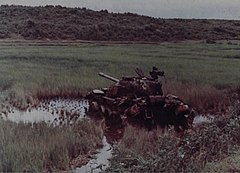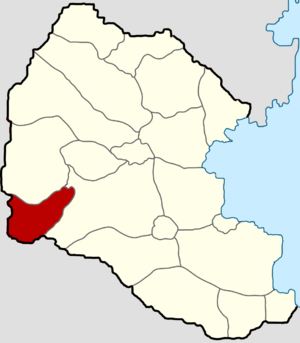Teyvada Crossing Incident
| Teyvada Crossing Incident | |||||||
|---|---|---|---|---|---|---|---|
| Part of the Terjasa Conflict | |||||||
 Lavanan Type-10 tank destroyed by Zomi militants | |||||||
| |||||||
| Belligerents | |||||||
|
| |||||||
| Commanders and leaders | |||||||
|
|
| ||||||
| Strength | |||||||
|
|
550 | ||||||
| Casualties and losses | |||||||
|
86 killed or wounded |
14 killed | ||||||
|
4 civilians killed | |||||||
The Teyvada Crossing Incident was a border incursion and later battle between paramilitary forces in support of the Union government of Zomia, and the People's Republic of Lavana, taking place in the border province of Terjasa, on the Lavanan side of the Teyvada River. Zomi paramilitaries were present on Lavanan territory from the 2nd to the 6th of February 1971, when they were routed decisively by Army and National Defence Units.
Following unsuccessful border negotiations and growing tensions between Zomia and its neighbor Lavana, the Union government sought to aid Ukilen nationalist and anti-communist groups in the Lavanan province of Terjasa. Such support, combined with repressive Anti-Ukilen laws in Lavana, resulted in an Ukilen uprising on the 15th of January. The Lavanan Army's limited response to the uprising encouraged militants of the Union-aligned Hsan Salvation Front to cross the border and loot abandoned Ukilen villages, soon joined by a patrol group of the Trucial Rangers. Lavana reacted more swiftly than expected against this Zomi aggression, expelling the incursion within days.
Background
In the years prior to the incident, the Peoples' Republic and the former Zomi Confederal State had failed to negotiate border adjustments over perceived inconsistencies in historical and ethnic boundaries, resulting from the Partition of Estmerish Southeast Coius in 1941. Although Lavana was a majority Kachai country, significant Ukilen and Veneran minorities existed in the western border provinces: historically this region had been heavily contested between steppe invaders, the valley-states of modern day Zomia, and the empires of modern Lavana and Dezevau. Although the Republic of Lavana had granted various rights to its minority groups, the victory of the Lavanan Section of the Workers International over the Republic in 1960, and the establishment of a People's Republic in Lavana, undid much of the progress these marginalised groups had made towards recognition. Since 1968 the Lavanan government had sought to dismantle the autonomy and cultural identity of its Ukilen minority, introducing a series of laws restricting the use of Ukilen language and symbols in education and regional government, and favouring Kachai speakers for state employment. Resultant ethnic and nationalist tensions led to the January Uprising of 1971 in Terjasa province, destabilising the borders of Lavana and the newly established Union of Zomia, which was also populated by a significant Ukilen minority. On the 15th of January Ukilen militias attacked National Defence Units and Kachai-majority towns and villages across Terjasa Province. The Lavanan army mobilised, but initially underestimated the strength of the uprising, resulting in heavy casualties. The Zomi government had been secretly supporting Ukilen forces, Trucial Rangers 'border patrol' units supplying the insurgency with military-grade weapons, intelligence and anti-socialist propaganda. Expecting to face light resistance, Lavanan units instead found themselves embroiled in heavy urban fighting against a well organised and entrenched enemy.
Even as the Union Government supported Ukilen nationalism across its border, the ethnic militias of the Hsan Salvation Front were given free reign to brutally suppress the Ukilen and Oegun populations of Nanpka State, in order to contain the spread of unrest into Zomia. Royalist forces had only recently defeated the United Zomi Councils - the Lavanan-supported socialist regime that had controlled much of the Zomi highlands during the 1960s - and established the Union, bringing an end to the Trucial Wars. Historians agree, however, that this did not reflect the strength of the royalist coalition so much as the weakness of the Zomi Section of the Workers International, which had already begun to suffer from factionalism and ethnic infighting as early as 1962 - but emboldened by this phoney victory over socialism, and the disruption of Lavanan border forces, the ill-disciplined militia of the HSF crossed the Zomia-Lavana border, unauthorised, on the 2nd of February.
Incursion
Under trial, Kau Nag Hai, Commandant of the 3rd Hsan Salvation Army, later claimed that Lavana had been aiding former leaders of the UZC fleeing over the border. In reality, the onset of the Ukilen Uprising had prompted all border forces to be pulled back, for fear of being cut off behind insurgent lines. Hsan Salvation forces crossed under the cover of night on the 2nd of February and encountered no resistance, passing through and looting abandoned Ukilen villages. The militia opened fire on a refugee camp on the morning of the 3rd, supposedly mistaking the unarmed civilians for concealed Lavanan border troops. Survivors fled the camp, reaching Lavanan Army lines around midday, and passing on news of the unprovoked Zomi attack. Lavanan reconnaissance aircraft tracked the HSF militia's movements, though General Oke Vorachith initially prohibited the use of aircraft to repulse the invaders, to avoid escalating the conflict, and instead began preparing ground forces and tanks for retaliation. On the 3rd, mistakenly encouraged by a perceived lack of resistance, a unit of Trucial Rangers assigned to resupply Ukilen insurgents at the border deserted their posts and joined in the looting and violence.
On the morning of the 4th, the Lavanan Army moved out, a vanguard force of 100 troops and a Type-10 tank making contact with the enemy around 9am on the outskirts of Anarba Township, exchanging fire with a scouting party of Trucial Rangers. Although the firefight was brief, the Rangers retreating swiftly for want of anti-tank equipment, the Lavanan advance was stalled by the engagement. By the time Anbara was secured, Zomi paramilitaries had been sighted on the approach. At around 1am the Hsan militia made their attack, engaging Lavanan forces in a 2 hour firefight for control of the village. Although casualties were light on both sides, General Oke Vorachith decided to use aerial bombardment to prevent further loss of Lavanan lives. A column of 450 men and 4 Type-10's traversed the Anarba outskirts, attempting to encircle the HSF. The push began at 2pm, and encountered resistance from the Trucial Rangers who had been scouting for Lavanan reinforcements, but the armoured advance was able to rout them. Militia and Ranger forces attempted to retreat over the border under cover of night at 8pm on the 5th, and Lavanan forces attempted to intercept. A single tank was lost to an ambush during the pursuit.
By the morning of the 6th, most of the attackers had escaped into the Zomi highlands. Isolated, encircled pockets continued to hold out until 4pm, when the few Zomi survivors surrendered, though the Lavanan government claims that Army and National Defence Units continued to encounter pockets of resistance for the following week. Some 16 Hsan Salvation Front militants and 4 Rangers had been captured.
Aftermath
The Teyvada Crossing Incident had a profound effect on both states. The Lavanan government held trials for captured Zomi combatants, including a Ranger captain, Gaw Uo Kyin, who proved to be of distant royal heritage: a great outrage and humiliation for the Union government. Lavana made easy propaganda of the captured militants to paint the Uprising in Terjasa as a foreign-backed subversion of the country's territorial integrity, largely discrediting the minority rights movement. In Zomia, distraught at the disloyalty and ill-discipline of its wartime militias, the Union government had dozens of Zomi paramilitary leaders subjected to show trials and execution, their soldiers consolidated into the Union Defence Force, answerable only to the Prince Presidency itself. The January Uprising the Union had abetted at great cost was short-lived, its leaders surrendering in March 1971, as Lavanan armour and airpower destroyed resistance in urban areas. Although an insurgency continued in Terjasa Province until 1994, the fighting never reached the intensity it had during the Incident. With the retirement of Lavanan Premier Saravan Khouph in 1978, Anti-Ukilen policies were finally repealed, as an attempt at reconciliation by his successor Buachan Inthavongsa. Lavana maintains a strong military presence in Terjasa and the Teyvada to this day, as a deterrent to future Zomi aggression. Though the incident has never been repeated, Lavanan and Zomi relations remain tense.
